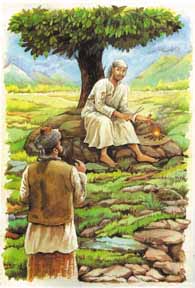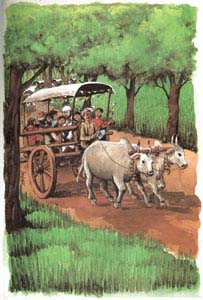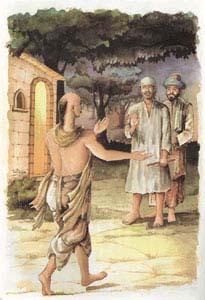|
|
|
 Sai
Baba and the Lost Horse of ChandBhai Sai
Baba and the Lost Horse of ChandBhai
In Maharashtra, there is a district named
Aurangabad, in which there is a village named Dhoopkhed.
Chandbhai was the patel of that village.
Once he lost his horse. Chandbhai searched
and searched, but to no avail. A week after, while he was
on the search, he noticed by the roadside a young lad of
sixteen, having sedate looks and wearing the garb of a fakir.
This beautiful boy with lustrous eyes
at once captured Chandbhai’s heart. Reading, as if
the onlooker’s mind, the fakir beckoned Chandbhai and asked,
“What are you looking
for, patel?”
|
|
 “I
have lost my horse. For this whole week, I am searching
him,” said Chand, approaching the fakir, with folded hands. “I
have lost my horse. For this whole week, I am searching
him,” said Chand, approaching the fakir, with folded hands.
“Then why go further? Your animal is grazing
beyond that hedge, there, look!” told the fakir, with a
gentle smile, pointing to a thick hedge beyond which nothing
could really be seen. Chandbhai went and saw, and lo! The
horse was found quietly grazing there.
Chandbhai was awe-struck. How did this
fakir recognize him as the patel, how did the boy know that
there was a horse beyond the hedge and that it belonged
to him – all this struck him with wonder. He was convinced
that the boy had a spark of Divinity in him. As Chandbhai
related this incident among his friends and
neighbours, the boy’s fame spread like a drop of oil on
the surface of water.
A few months later, a marriage procession
went from Dhoopkhed to Shirdi. The boy-fakir also accompanied
it.
|
|
 When the procession reached the outskirts of Shirdi, it
stopped to pay homage to God khandoba. Mhalsapati, the priest
of Khandoba temple, eyed the fakir, and, out of spontaneous
admiration, exclaimed, ”welcome, ye Sai Baba”.
When the procession reached the outskirts of Shirdi, it
stopped to pay homage to God khandoba. Mhalsapati, the priest
of Khandoba temple, eyed the fakir, and, out of spontaneous
admiration, exclaimed, ”welcome, ye Sai Baba”.
It was as if the Divine
Will that had given the boy this name, for that very name
stuck to him all his life. From that day (1854), the boy
stayed in Shirdi.
|
|
|
|